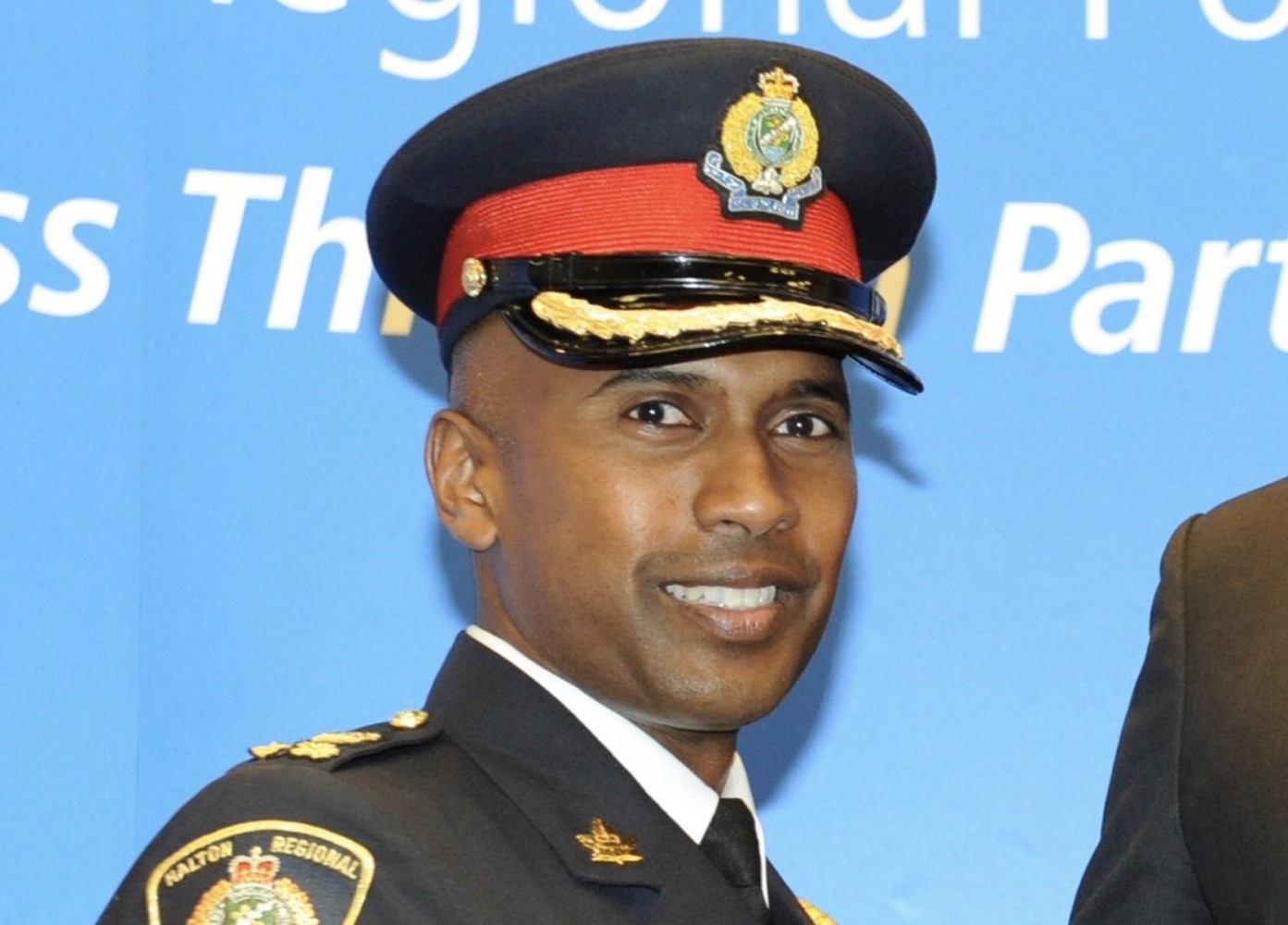
Incoming chief talks priorities and vision for Peel police
Nish Duraiappah is one happy police officer. Just scroll through his wholesome Twitter feed:
beaming selfies with officers, politicians and community members, pictures of policing accomplishments by Halton Regional Police (of course, thanking any other organizations involved), and countless retweets and reminders about community events. In May, Duraiappah is seen singing and strumming his guitar during a show for Halton’s annual Police Day. The collection of tweets is so warm, they should be sepia-toned.
More recently, the feed has been filled with thank-yous.
Late on the Friday before the August long weekend, the Peel Police Services Board released the news that Duraiappah was its chosen candidate to become the new chief of police. The news ran riot on social media, apparently surprising many users who had been on the verge of checking out digitally for the long weekend. The appointment was heralded by local, provincial and federal politicians, organizations and police, all of whom either thanked the deputy chief, wished him well in his new role, or praised his many accomplishments.
By the looks of his Twitter feed, Duraiappah thanked each and every one of them.
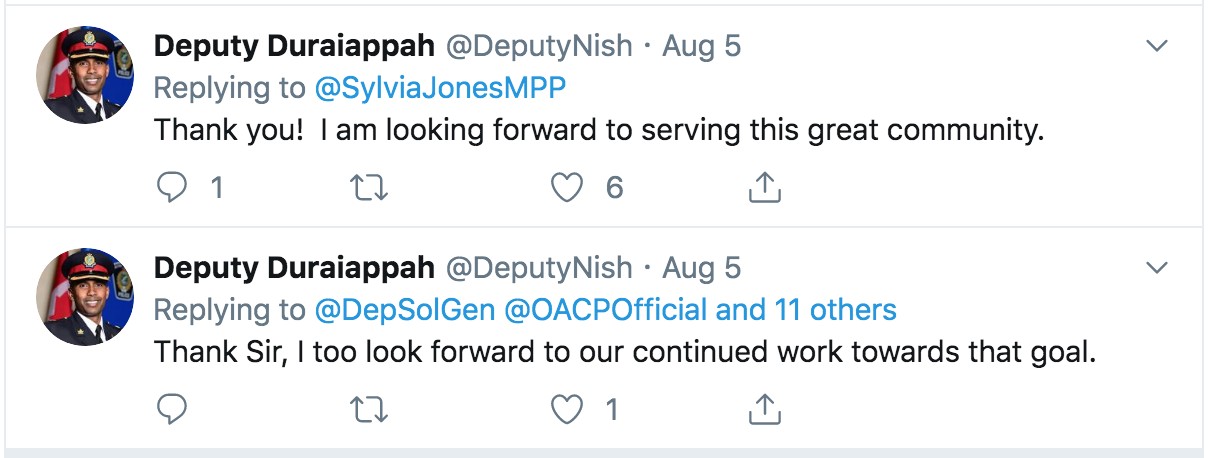
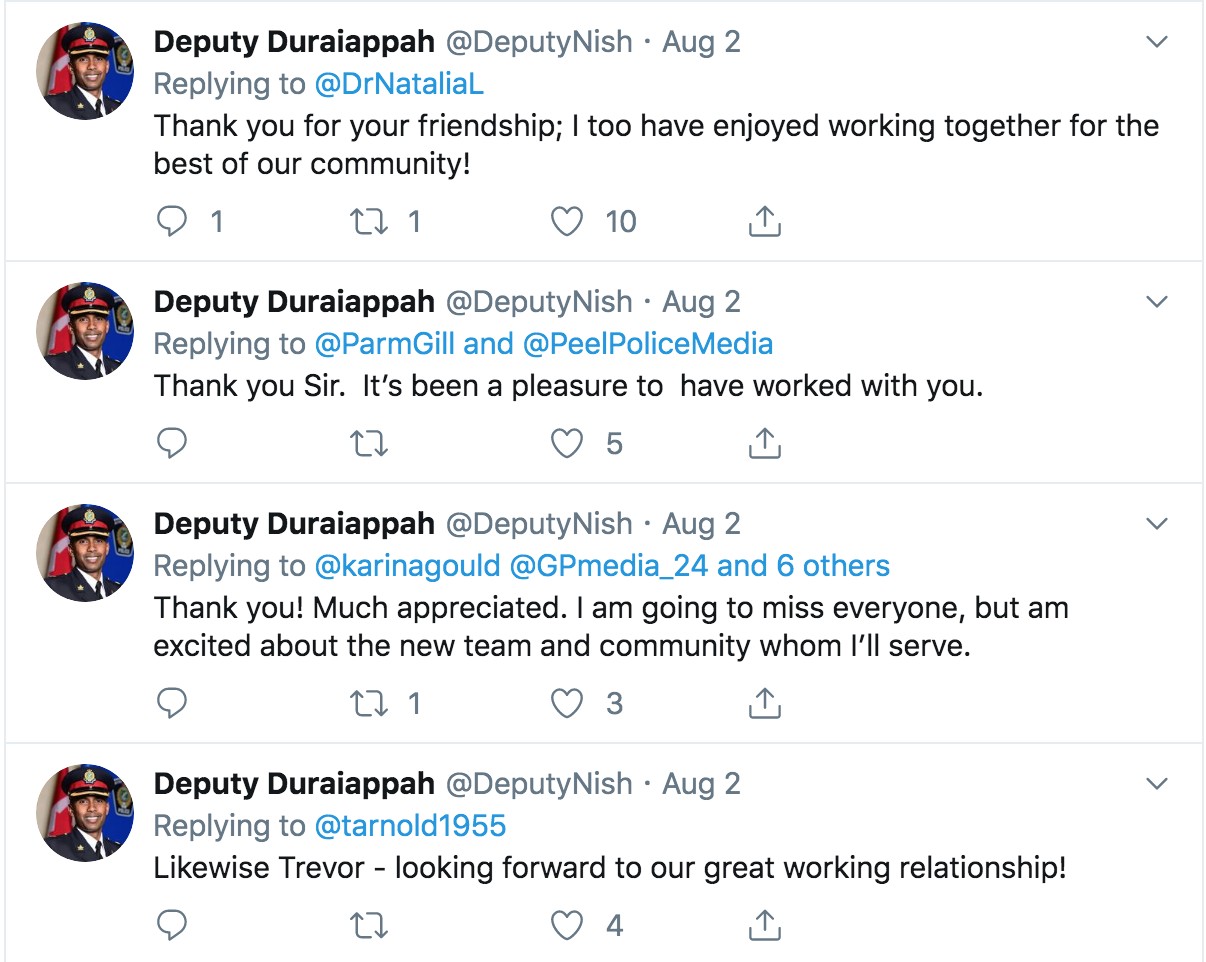
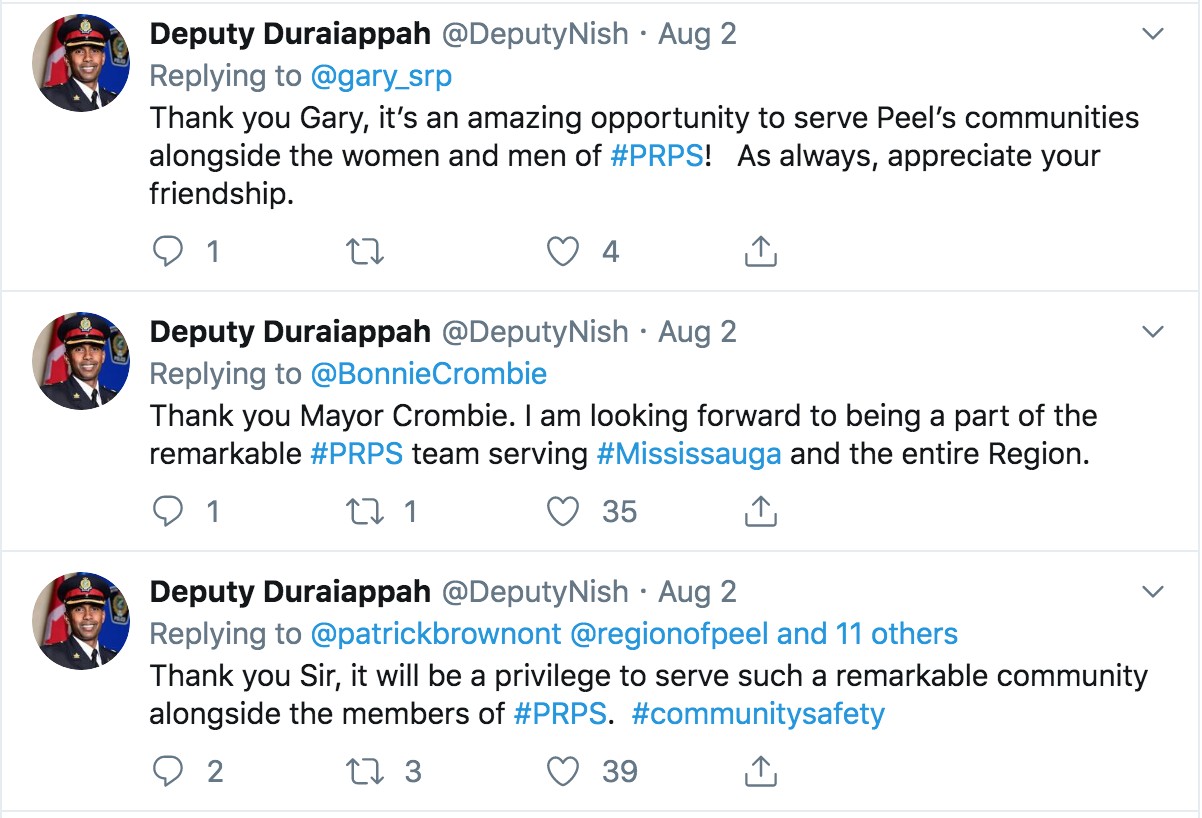
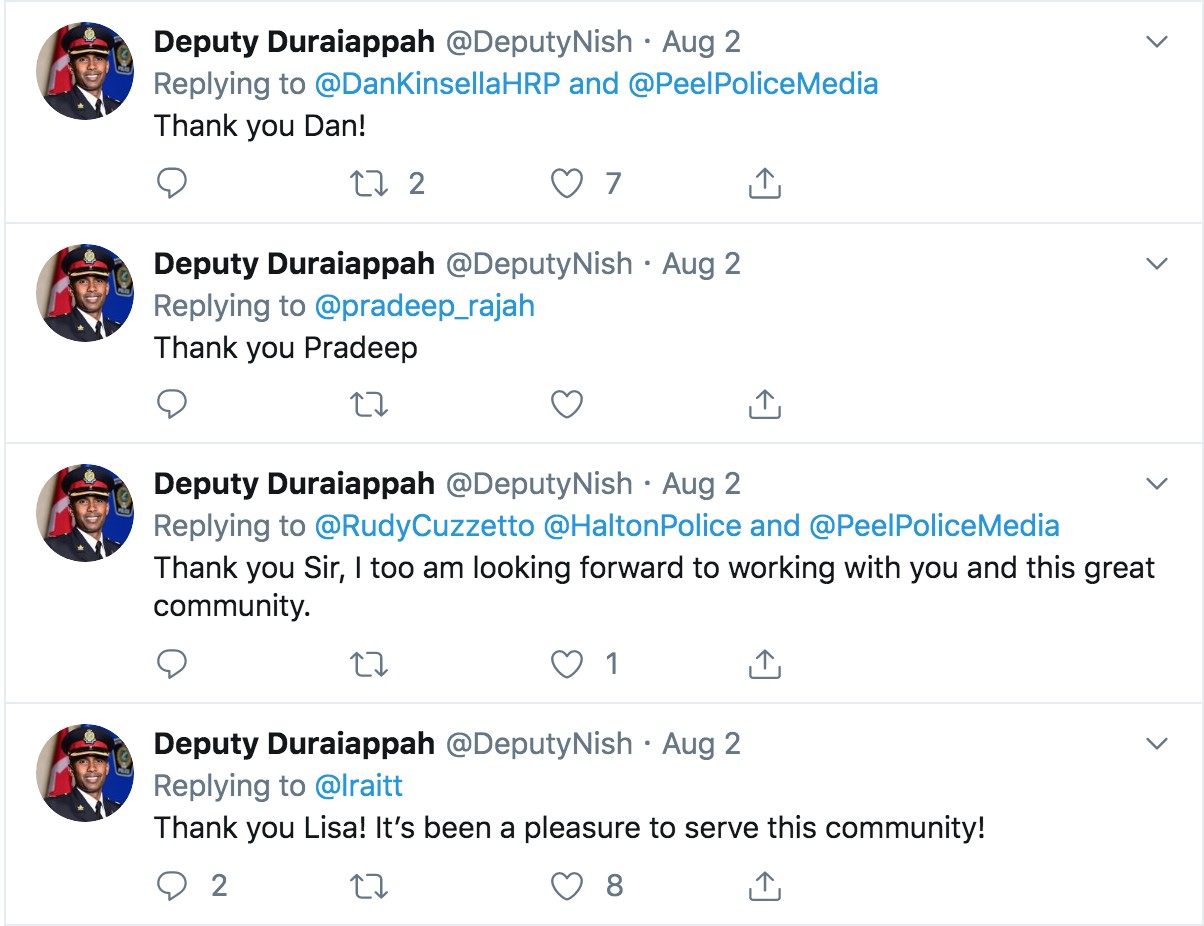
The use of social media by police officers has become a growing phenomenon over the past decade — the NYPD even has a guide for officers on how best to use social platforms — and often has been used successfully to connect with the community they serve. This progressive approach has been embraced by a newer generation of officers who not only see the benefits of connecting more deeply with citizens, but also see the role of a police officer as more than fighting crime.
Duraiappah takes the helm of the Peel Regional Police Service in October, bringing with him not only his social media savvy but also a progressive mindset that just might shake off the cobwebs of rigid, traditional thinking.
---
Duraiappah releases a long breath when asked the question about how all this feels. He’s full of mixed emotions, he says. There’s a lot to unpack when departing from a community where you’ve spent the entirety of your career.
He will depart his role as deputy chief for Halton Regional Police and officially take the helm in Peel at the start of October. He will be the first police chief of South Asian heritage in Ontario’s history.
“When I started, I never had the idea or the inclination that this would be where I’d like to end up,” Duraiappah tells The Pointer.
Born in Sri Lanka, he says policing wasn’t something his parents ever encouraged him to do. However, after arriving in Canada, he had the opportunity to get a close-up look at the job through a specialized youth program offered by HRPS at the time.
In 1991, Duraiappah was in high school and took part in the Halton Police Ethnic and Cultural Education (PEACE) program. Reflecting the down-to-earth attitude that serves him well in his role today, Duraiappah says he was immediately attracted to policing because of the relationships that can be built between officers and the communities they protect. He realized he could easily see himself in the role. In the early ’90s, that had to have been a rare perception, as police forces across the country were — and still are — grappling with a dearth of diversity in their ranks.
Duraiappah could not only see himself as a police officer, but found himself drawn to it.
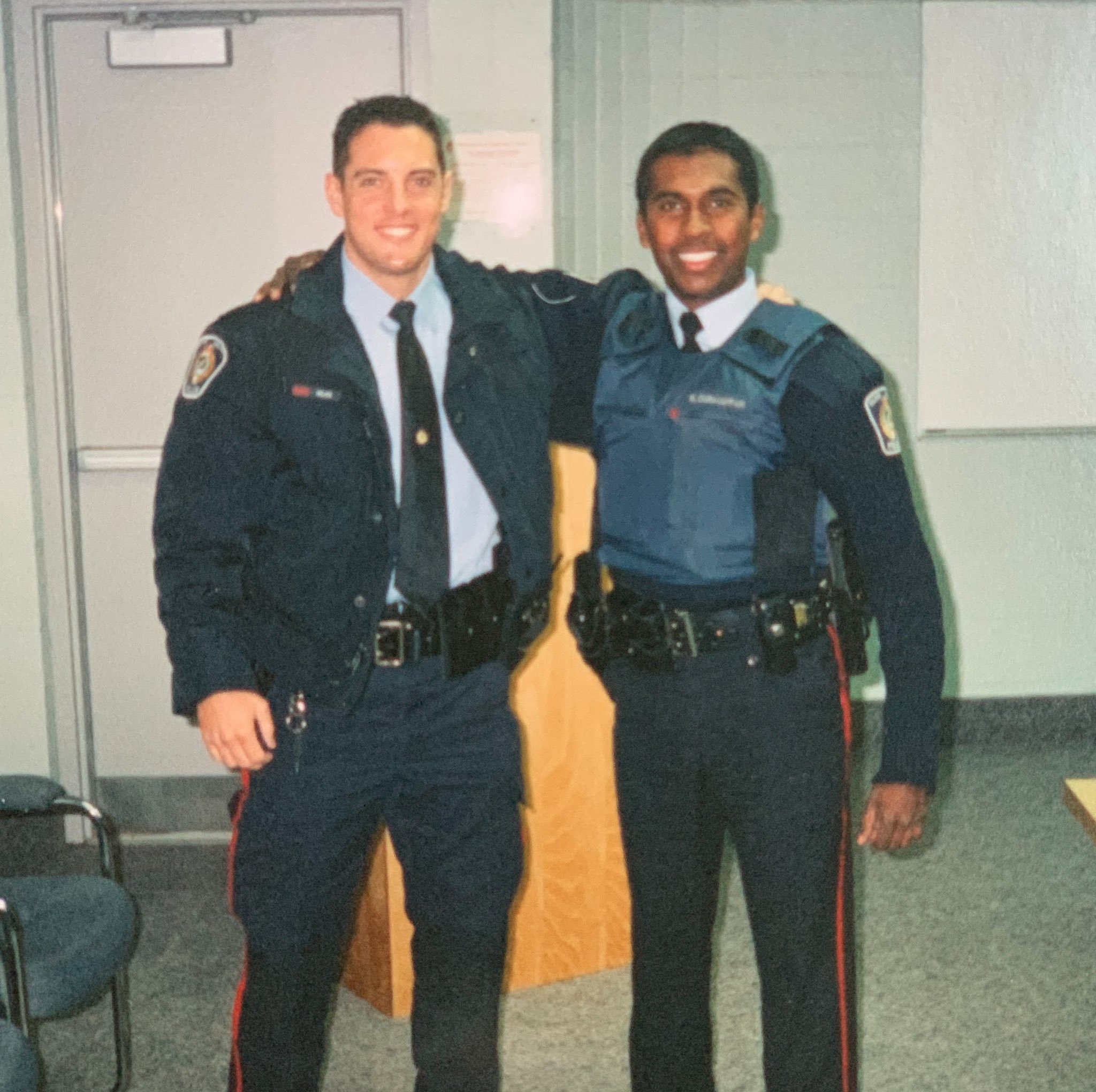
Duraiappah (right) early in his policing career with Halton.
“What shocked me was understanding that [officers] are members of the community — they’ve got families, they’ve got interests, they’ve got their own personal challenges — and what the few that I got exposed to did for me was really extend themselves to me,” he says. “The key to that is how important relationships are, no matter what profession you’re in.”
For the new leader of Peel Regional Police, it will be an asset to see relationship-building as a priority.
Duraiappah waves off any focus on his historic achievement as the first South Asian in the top job; instead, he wants to put the focus on the profession and what being in this new role could mean for the community.
“I really want the focus to be on how amazing this profession is, first and foremost,” he says. If others can relate to his immigrant experience and resonate enough with his success to see themselves as potential police officers, then, Duraiappah says, all the better.
However, he acknowledges that his background will be an asset in connecting with the Peel community. “It’s a door to open new conversations with new communities.”
For the large South Asian communities in Brampton and Mississauga, those words will come as a breath of fresh air. Peel police have been publicly admonished in the past for not valuing policing in those communities.
In 2017, the Ontario Human Rights Tribunal put official words to the complaints many people in Peel had been airing for years, essentially saying the police service had a toxic internal culture that needed to change.
It ruled that year that the force had discriminated against decorated South Asian officer Baljiwan (BJ) Sandhu, denying him the chance to compete for promotion into the senior ranks. It also said Peel police routinely devalued policing within the South Asian community. Evidence in the case revealed the use of racist language and behaviour within the force and what seemed like a frat-house culture that mocked diversity.
The tribunal went even further, ruling that Sandhu's rejection was due, at least in part, to his ethnicity. "As such I find that the applicant has been subject to discrimination because of race, ancestry, place of origin, and ethnic origin in violation of … the [Human Rights] Code," Bruce Best, vice-chair of the tribunal, wrote in the decision.
The tribunal further noted that police portfolios rooted in the South Asian community are "generally devalued in the service" because they are "associated with the South Asian population" and are "not considered real police work.”
“We all know that policing has had its challenges in the last five to 10 years,” Duraiappah says. “Public confidence and the legitimacy of policing are always front and foremost, but if [my background] is a starter or a conversation piece for an individual or a particular community that [has] a different profile — the end game is always to leverage what we can to increase public safety and the profession itself.”
Duraiappah says he is well aware of the damning findings and recommendations of an equity audit of Peel police completed last year by the Canadian Centre for Diversity and Inclusion (CCDI).
Duraiappah says Halton police had a similar audit completed in recent years, with similar findings and recommendations.
“So I was familiar with the recommendations and the themes that were brought forward as a result of what was done in Peel,” he says. “At its core, a lot of the same issues, obviously [with] varying scales across the policing sector, are what police chiefs and leaders are managing wherever they are, trying to encourage a real reflection of what the community looks like.”
Duraiappah says the internal operation of an organization is a good barometer of how it operates on the outside. If the inside is healthy, then the outside should be smooth sailing as well. The opposite is also true.
“When [things that happen] between the four walls of the organization are good and healthy, that is where, at the street side, people get a real feeling that the organization is also connecting well with the public.”
In Peel, the CCDI audit findings illustrated many internal issues, including rampant discrimination and higher ranking officers who appeared unwilling to address the issues or take advice.
Based in part on surveys, interviews and focus groups in 2017 and 2018, it showed some startling disconnects between upper ranks of the police service and board and the frontline officers and civilian staff:
-
93 percent of police leaders surveyed believed the force was committed to diversity and inclusion and that it exhibited fairness, consistency and flexibility. In contrast, only 41 percent of focus group respondents [composed of volunteer participants from within the police service] had a positive response to this question, the report says; straight, white, able-bodied men were the most likely to agree. “None of the Racialized or Newcomer respondents responded positively.”
-
About a third of the PRP leaders in place in 2017-18 “indicated their belief that these systemic oppressions do not exist within PRP,” while others suggested they believe “these oppressions manifest only as individual acts of meanness.” These leaders, the report says, don’t make “the connection that these oppressions are systemic in our society and therefore are also in our organizations.” However, when rank-and-file employees were asked if “everyone benefits from equal access to resources and opportunities” within the PRP, only half of the more than 1,800 who filled out a survey offered a positive answer. According to Michael Bach, founder and CEO of CCDI, an industry benchmark for such a question is 70 percent.
The CCDI report places most of the blame for these problems on senior leadership, with a majority of employees describing the organization as “change-averse” and “elitist.” The report says almost three-quarters of police leaders and members of the board “do not seem to recognize that barriers exist or [believe they] rarely exist for certain groups at Peel Regional Police.”
Duraiappah says his priorities will include not only carrying out the recommendations of the audit but also focusing on the deep-seated changes needed within the organization.
“It really has to be an authentic journey; it can’t be activities for the sake of checking boxes,” he says. “You have a workforce that it’s important to, as well. They want to believe that the organization has got a strong culture that is deeply authentic in what its values are, that it [is transmitted] into hiring practices and … into the way that we deal with civilian and sworn officers.”
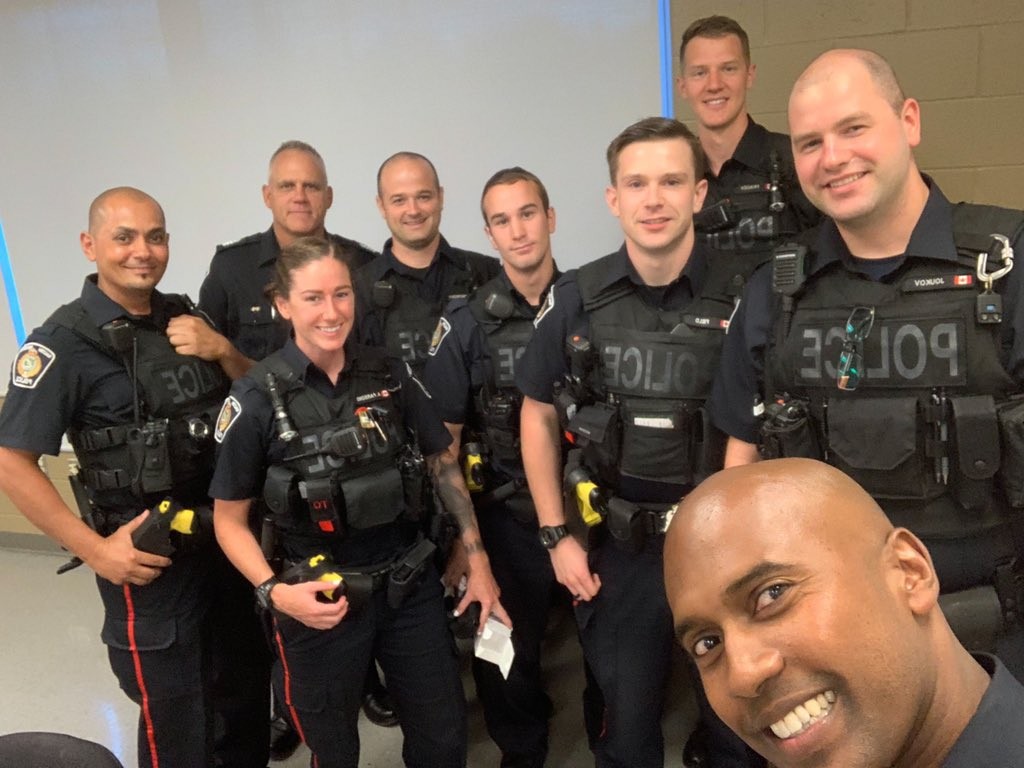
Duraiappah snaps a selfie with his fellow Halton police officers.
Duraiappah admits that discussions around diversity and inclusion typically boil down to recruiting and hiring. In this regard, the police service has already started to make some progress. According to 2017 data, 20 percent of uniform staff were racialized (425, out of a total uniform complement of 2,080), while the service’s jurisdiction, Brampton and Mississauga, is 65 percent visible minority and Aboriginal. In contrast, 2018 numbers show that 60 percent of new uniform hires in 2018 were classified as racialized persons.
But Duraiappah says change in terms of diversity and inclusion needs to go much further than who gets hired.
“It’s building the resiliency within an organization, to really value equity and diversity and inclusion,” he says. “That will be one of my significant initial activities, to set the road map for how the organization is really going to achieve that, not just for the year or two when responding to the audit, but really to build some resiliency for this organization and the community for the years to come.”
---
In 2018, the Peel Police Services Board, at the urging of former chief Jennifer Evans, approved hiring 55 additional officers for this year, with tentative plans to continue hiring at the same level for several years ahead.
Evans’ urging came as Peel was in the eye of a storm, when the region was seeing drastic increases in violent crime. All types of violent crime, taken together, increased by 13 percent over 2017 and by 33 percent compared to 2014. These numbers were led by a 166 percent increase in homicides over 2014, a 321 percent increase in attempted murder charges, and a 332 percent increase in sexual violations against children compared to five years ago.
Peel’s response was in keeping with the traditional view, championed by Evans and a large collection of police leaders, that more officers is always the correct response to an increase in crime. The size of increases in police budgets tends to correlate with a rise or decline in crime within the jurisdiction. Secondly, and perhaps understandably, putting more officers on the street gives the concerned public a visible response to stand behind.
“The public does want to see and feel and hear that it’s a priority, and quite often one of the most tangible ways is by articulating the amount of additional resources,” Duraiappah says.
However, the incoming chief acknowledges this traditional response is not sustainable.
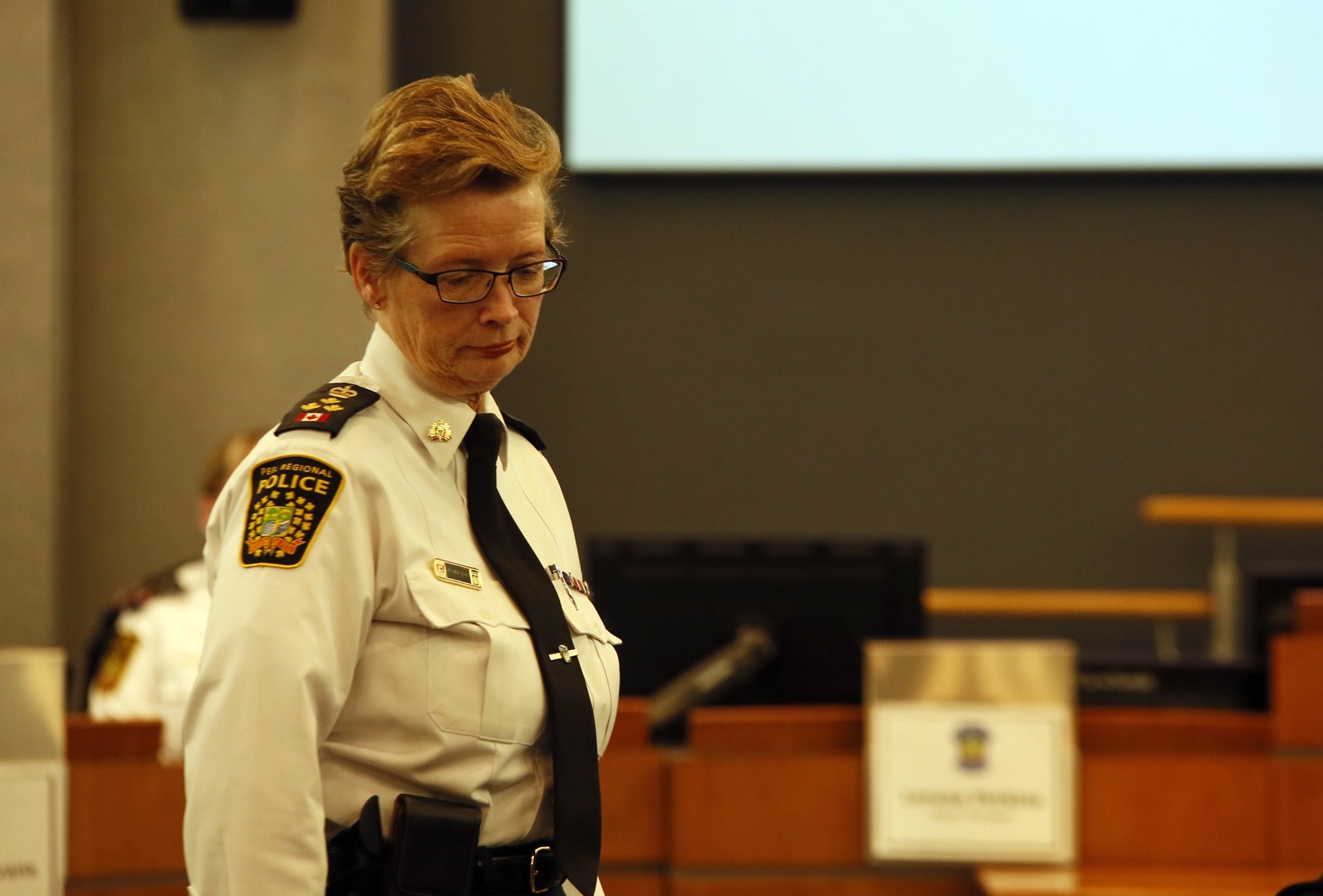
Former Peel police chief Jennifer Evans
In the years ahead, Peel will need to focus more on “upstream” prevention models. While acknowledging that funding from other levels of government for this approach would be welcomed, it is not essential, Duraiappah says.
It’s possible to find ways to mitigate risks by working with community partners, for example by pairing police officers with social workers to respond to mental health calls — one of the top reasons for citizen-initiated calls to police.
This is an initiative Peel police have been undertaking for some time. They recently received a boost in provincial funding to bolster their partnership with the Peel-Dufferin branch of the Canadian Mental Health Association. The two organizations partner in Mobile Crisis Rapid Response Teams (MCRRT), of which there are now four in Peel/Dufferin. These teams respond to mental health–related 911 calls, helping to de-escalate tense situations and prevent harm to both the individual in crisis and bystanders. That helps free up police resources to focus on actual crimes.
Statistics confirm the need for such initiatives. In 2017, the police force received more than 5,800 requests for help in mental health crises, a 15 percent increase over the year before. MCRRT programs alleviate pressure not only on police but also hospital emergency departments, by channelling people suffering from a mental illness to appropriate treatment instead of allowing a crisis to proceed to the point where it results in the patient in being jailed or hospitalized — or worse.
A focus on “upstream” preventative measures, to prevent crime before it happens, typically also translates into youth programming and social development initiatives to help keep kids away from paths that lead to crime.
“We’ll always be the experts on catching the bad guys, but we are also having to turn our minds to forward-thinking models,” Duraiappah says. “That’s the kind of thing that I’ve committed to the police services board, and that’s to start weaving these opportunities into how Peel Regional Police [operates], moving forward into the future. It is a philosophical change that is going to have to take seed right where the rubber hits the road.”
---
Members of the Peel Police Services Board who participated in hiring Duraiappah offered strong words of praise after the announcement.
“He brings a new and innovative style of policing to Peel, representing the next generation of leadership on the force,” said Mississauga Mayor Bonnie Crombie, a long-time champion of progressive policing methods in Peel.
Brampton Mayor Patrick Brown said he has “long advocated for the hiring of a new chief with experience and fresh perspectives on how best to handle the growing number of 911 calls that are mental health–related and gun violence in Peel Region. … On these issues, and many others, I have the utmost confidence Deputy Chief Duraiappah is going to do an exceptional job for Brampton and Peel Region as our new Chief.”
Duraiappah’s progressive views may face challenges within the police leadership in Peel, which has not always shown itself open to new ideas. Former chief Evans, for example, openly battled Crombie’s motion to suspend the police practice of carding, or random street checks, which had been proven statistically to disproportionately target Black residents.
Yet, when asked if there are any nerves coming into his new position, Duraiappah shrugs it off. Change is useful, he says, and something to be embraced, though he admits that at times it can be difficult.
“It proposes a new way of doing things that is uncharted, perhaps, without a lot of certainty on when you’re going to see the return on investment. So without a doubt, whether it was in Halton or in Peel, it’s a journey, for sure,” he says. “I think part of it is bringing together a key group of people that understand this is not going to be overnight; this is going to take time. It has to be communicated well and people have to understand the value of it, but if we can’t keep up with change, we will be left behind.”
---
Duraiappah is a champion for a good work-life balance.
With three kids between the ages of 8 and 13, the incoming chief admits that things can be hectic, even when he’s not transitioning into a new role as one of Ontario’s top cops.
Despite that, it’s clear from his Twitter feed that finding a healthy balance between work and play is no issue for this officer. Duraiappah seems just as at home enjoying a joking selfie competition with fellow officers, or displaying his fondness for jiu jitsu (in which he holds a black belt), as he does when discussing progressive policing.
In speaking about the role of a police officer, it becomes clear that Duraiappah views it as much more than just conducting investigations or frontline policing. “I think there’s a greater good to be done in policing that doesn’t attach itself to what uniform or shoulder patch you have,” he says.
It’s clear Duraiappah will be a chief like none Peel has seen before. (Former chief Evans didn’t even have a Twitter account.) But he knows that to succeed, the forward-thinking mindset he brings to Peel will have to permeate the entire organization.
“I often say [to] the officer we’re hiring today — 15 years from now, we will not understand what policing will be like. We don’t know what kind of communications systems they’re going to be using, what taking a report will look like, what the pressures are. The same way that many officers that started 15, 20, 30 years ago — there weren’t computers in the cars,” he says. “We need the strategic foresight to say we’re creating a profile of an officer that’s flexible, that can adapt to the changing environment. … It can’t be a job description that’s in a box, it has to really be something that’s open and flexible.”
Since “open” and “flexible” aren’t words that have been used often to describe Peel police, it’s clear Duraiappah will have his work cut out for him.
Email: [email protected]
Twitter: @JoeljWittnebel
Submit a correction about this story


